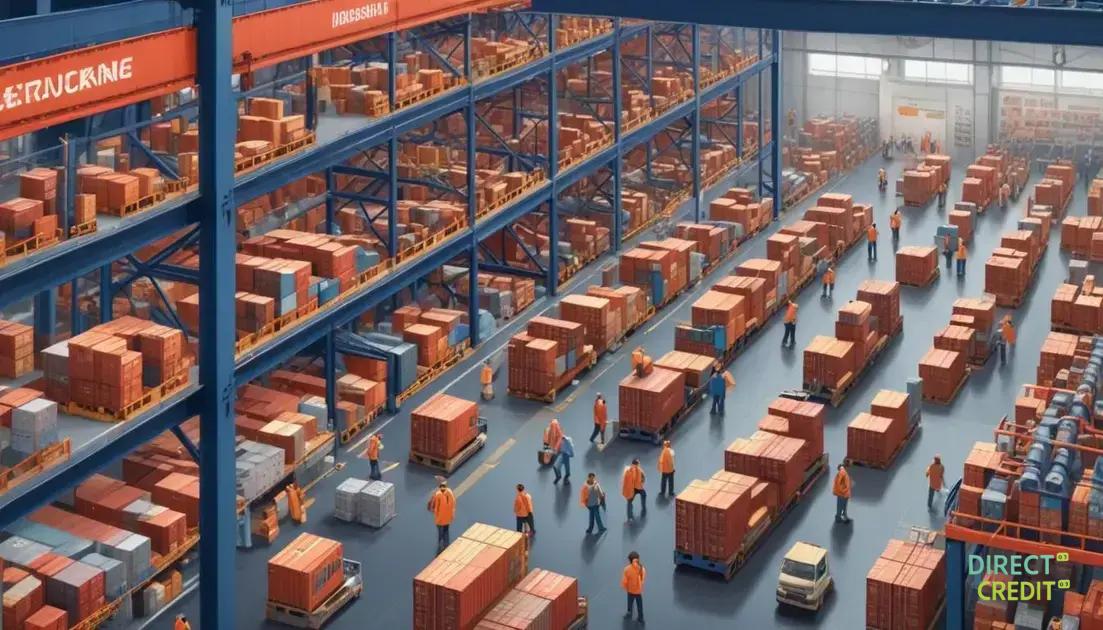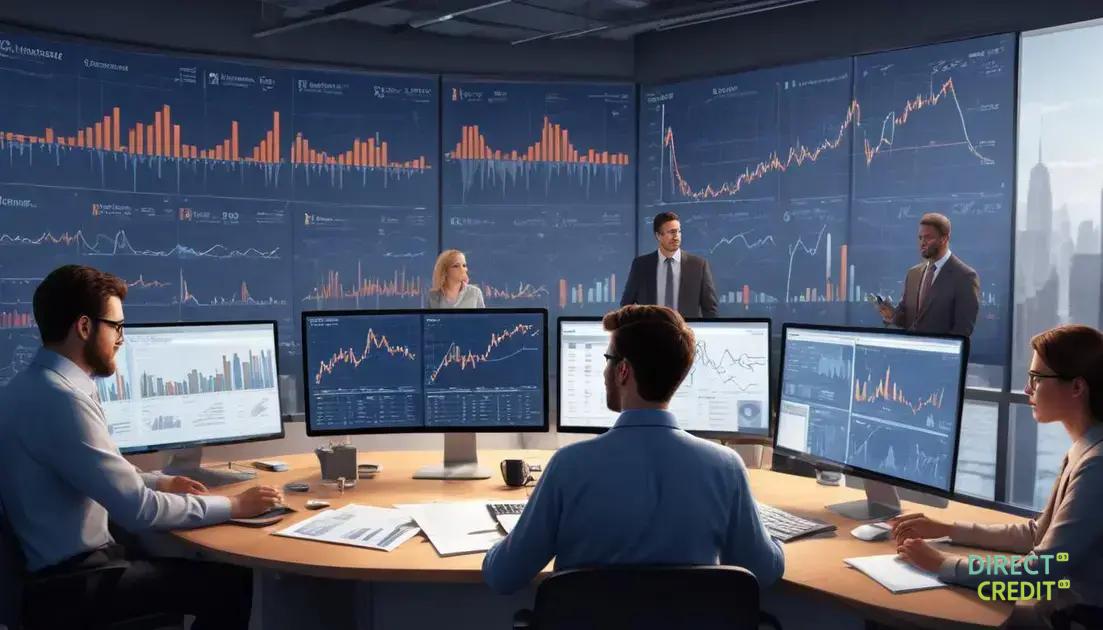Tariff-induced inflation risks: What you need to know

Tariff-induced inflation risks arise when tariffs increase the cost of imported goods, leading to higher consumer prices and reduced purchasing power, impacting financial stability and economic growth.
Tariff-induced inflation risks are becoming increasingly relevant as global economies adjust to new trade policies. Have you noticed higher prices at your local store? This article explores how tariffs can impact costs and what that means for your wallet.
Understanding tariff-induced inflation
Understanding tariff-induced inflation is essential as it affects our economy and daily lives. When tariffs are imposed, they can lead to increased prices for goods and services, impacting consumers everywhere.
One key factor in this process is how tariffs affect supply chains. When a tariff is applied, the cost of importing materials or products rises. Thus, companies might pass those costs onto consumers, causing prices to spike. Understanding this connection is vital for everyone.
Factors Contributing to Tariff-induced Inflation
Several elements drive this type of inflation. Here are the main contributors:
- Increased production costs due to higher material prices.
- Decreased competition leading to higher prices.
- Market adjustments that shift supply and demand.
With these factors at play, it’s clear that tariffs can create a domino effect within the economy.
In addition, consumer behavior often changes in response to rising prices. When certain products become more expensive because of tariffs, consumers may seek alternatives, inadvertently affecting other markets. Furthermore, businesses might have to adjust their pricing strategies to maintain customer loyalty. This interplay between tariffs and consumer choices adds another layer to understanding tariff-induced inflation.
Real-World Examples
For instance, in recent years, the tariffs on steel and aluminum led to increased costs in various industries like construction and manufacturing. As a result, consumers faced higher prices for cars, cans, and other products.
Overall, grasping how tariff-induced inflation manifests helps consumers and businesses prepare for potential economic shifts. Awareness of these trends allows us to navigate challenges more effectively, ensuring better financial planning in uncertain times.
Factors driving tariff-induced inflation

Factors driving tariff-induced inflation are crucial to understand how trade policies affect our economy. Tariffs can lead to increased costs, supply chain disruptions, and price hikes for consumers.
One major factor is the increased cost of imported materials and those subsequently used in manufacturing. This change often results in companies raising prices to maintain profit margins. It’s important to recognize this domino effect as it cascades through various sectors.
Key Contributors
Several elements contribute to tariff-induced inflation:
- Higher import prices, which affect production costs.
- Reduced competition among local suppliers.
- Changes in consumer demand due to price increases.
Understanding these contributors can help consumers and businesses prepare for changes in the market.
In addition, tariffs can alter consumer behavior. When prices rise, buyers may look for alternatives, which affects different markets. This shift can lead to a decrease in demand for more expensive products, impacting retailer strategies. As prices fluctuate, businesses must adapt to the ongoing economic landscape to remain competitive.
Market Reactions
Another aspect to consider is market adaptability. Companies might respond by optimizing their supply chains or sourcing materials locally to mitigate rising costs. In some cases, they may even relocate production to areas with lower tariffs. This flexibility can somewhat cushion the impact of tariff-induced inflation on consumers.
In summary, recognizing the factors driving tariff-induced inflation helps us navigate the complexities of modern economies. Being informed allows for better financial planning in response to these ongoing changes.
Impact on consumer prices and purchasing power
The impact on consumer prices and purchasing power is significant when tariffs are introduced. As tariffs increase the cost of imported goods, consumers often find themselves paying more at checkout. This increase affects everyday items, from groceries to electronics.
When companies face higher costs for materials due to tariffs, they typically pass those costs onto consumers. For example, if a manufacturer has to pay more for imported components, it will likely raise the prices of finished products. This chain reaction leads to a general rise in prices over time.
Effects on Purchasing Power
With rising prices, consumers’ purchasing power decreases. This means that people can buy less with the same amount of money. Consider the following effects:
- Reduced spending on non-essential goods.
- Changes in consumption patterns, with consumers seeking cheaper alternatives.
- Potential strain on household budgets as essentials become more expensive.
As prices increase, many shoppers start to feel the pinch. They might decide to cut back on dining out or delay purchasing larger items. Understanding how tariff-induced inflation impacts consumer behavior helps explain broader economic patterns.
Moreover, low-income families often feel these impacts the hardest. As their budgets are tighter, they cannot easily absorb higher prices. This can lead to stressed family finances, impacting overall well-being.
Broader Economic Implications
The broader economy can also feel the effects of changing purchasing power. When consumers spend less, businesses may struggle to maintain sales levels. Companies could respond by limiting hiring or reducing wages. This cycle can lead to lower economic growth, affecting the overall job market.
In summary, the impact on consumer prices and purchasing power serves as a crucial indicator of economic health. Analyzing these changes provides insight into how tariffs influence not only individual spending habits but also the wider economy.
Long-term economic implications

The long-term economic implications of tariff-induced inflation can be profound. Over time, these tariffs can shape the landscape of an economy, affecting everything from job markets to consumer behavior.
One significant consequence is the potential for slower economic growth. As prices rise, consumer spending may decline, which can lead to decreased business revenue. This slowdown can affect investment and hiring, further slowing growth.
Job Market Effects
With reduced economic activity, the job market may suffer. Companies facing lower sales might freeze hiring or even lay off employees. Key impacts include:
- Increased unemployment rates.
- Reduced job security for workers.
- Potential wage stagnation as companies cut costs.
These shifts can create a cycle of hardship for families and communities, leading to wider economic instability.
Additionally, industries that rely heavily on imports may be adversely affected. When tariffs increase their costs, they may struggle to compete, leading to market exits and further job losses. For instance, sectors like manufacturing might relocate production to countries with lower tariffs or regulations, exacerbating domestic economic challenges.
Inflationary Pressure on Investments
Another long-term implication is inflationary pressure on investments. Investors might hesitate to invest in an environment of uncertainty. This hesitation can limit innovation and technological advancements as funding becomes scarce.
This lack of investment can stifle productivity growth, which is crucial for a healthy economy. As productivity lags, so does potential wage growth, affecting the standard of living for many households.
In conclusion, the long-term economic implications of tariff-induced inflation highlight the importance of understanding trade policies. Awareness of these factors can prompt better economic strategies at both the individual and governmental levels, fostering resilience against future economic shifts.
Strategies to mitigate inflation risks
Implementing strategies to mitigate inflation risks is essential for consumers and businesses alike. Understanding how to navigate the effects of inflation can help maintain financial stability and protect purchasing power.
One effective approach is to diversify investments. By spreading investments across different asset classes, individuals can reduce their exposure to inflation. This strategy may include stocks, bonds, real estate, and commodities. Each type of investment reacts differently to inflation, allowing for a more balanced financial portfolio.
Budgeting and Financial Planning
Creating a detailed budget helps individuals and families keep track of their spending, ensuring they make informed financial choices. Key practices include:
By focusing on budgeting, consumers can navigate the challenges posed by rising prices, ensuring they remain within their means.
Another strategy involves seeking higher wages or additional income through side jobs or freelance work. As inflation increases, employers may be willing to negotiate salaries to retain talent, making it a good opportunity for employees to advocate for fair compensation.
Staying Informed About Market Trends
Staying updated on market trends can also help in making educated purchasing decisions. Consumers should be aware of price fluctuations and adjust their buying behavior accordingly. For example, shopping during sales or comparing prices can lead to significant savings.
Moreover, joining community groups or forums discussing inflation can provide valuable insights and tips. By sharing experiences and strategies, individuals can learn from each other, enhancing their resilience against inflation.
In summary, utilizing these strategies to mitigate inflation risks can help individuals and businesses maintain financial health in uncertain economic times. Adapting to changes proactively allows for better management of finances and resources.
In conclusion
Tariff-induced inflation risks present significant challenges for consumers, businesses, and the overall economy. Understanding the implications of tariffs is vital for managing financial health and making informed decisions.
By recognizing the factors driving inflation, the consequences on consumer prices, and the long-term economic effects, individuals can better prepare themselves.
Utilizing strategies to mitigate these risks, such as effective budgeting, investing wisely, and staying informed, can empower people to navigate the complexities of the current economic climate.
Adapting to change and taking proactive measures will help protect purchasing power and ensure financial stability for the future.
FAQ – Frequently Asked Questions about Tariff-Induced Inflation Risks
What are tariff-induced inflation risks?
Tariff-induced inflation risks refer to the potential for rising prices on goods and services due to tariffs imposed on imported products, which can affect consumers’ purchasing power.
How do tariffs impact consumer prices?
When tariffs increase the cost of imported goods, companies often raise their prices to maintain profit margins, leading to higher costs for consumers on everyday items.
What strategies can individuals use to mitigate inflation risks?
Individuals can mitigate inflation risks by budgeting, diversifying investments, seeking higher wages, and staying informed about market trends.
How does inflation affect long-term economic growth?
Inflation can slow down economic growth by reducing consumer spending, which may lead businesses to cut back on hiring and investments, ultimately impacting job markets.





